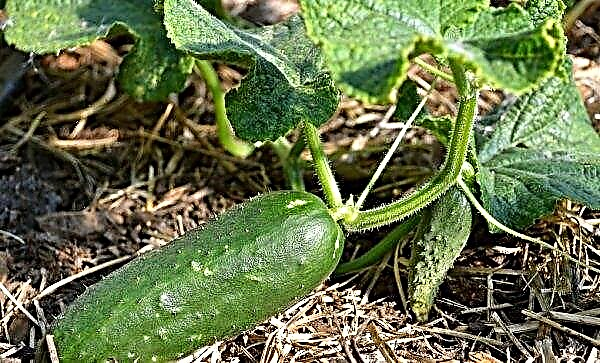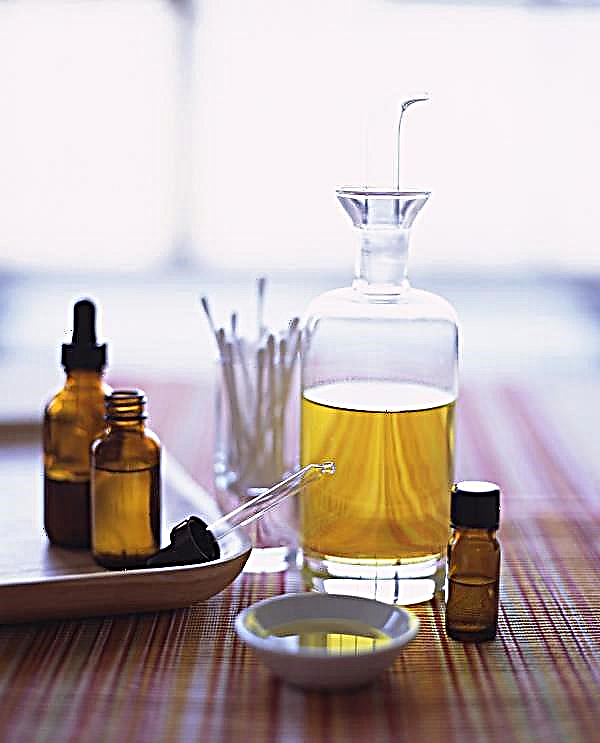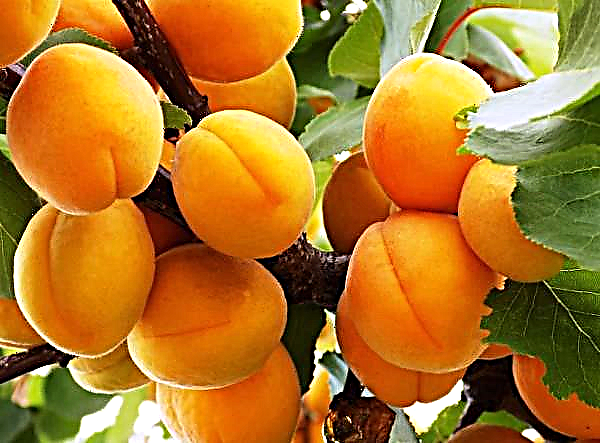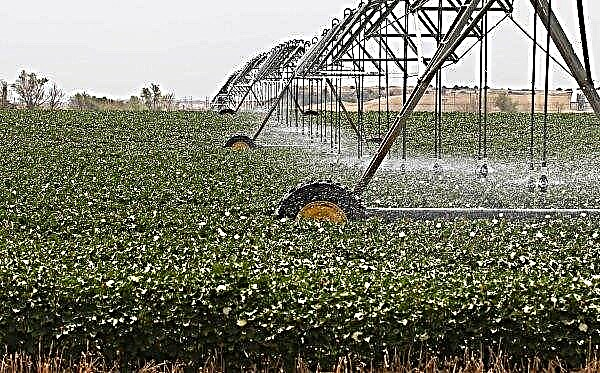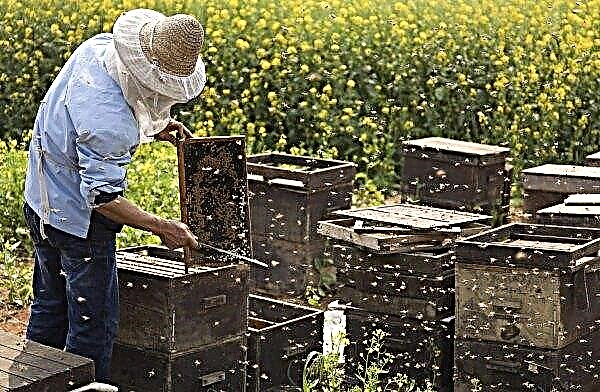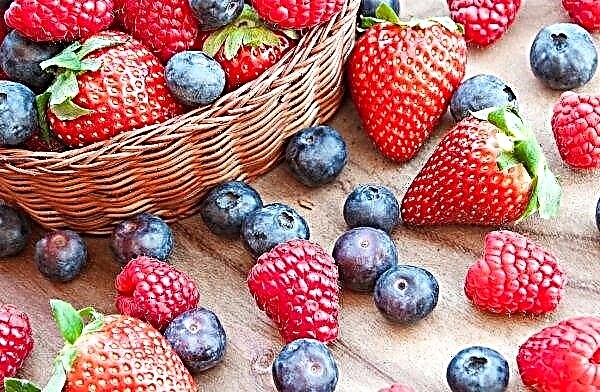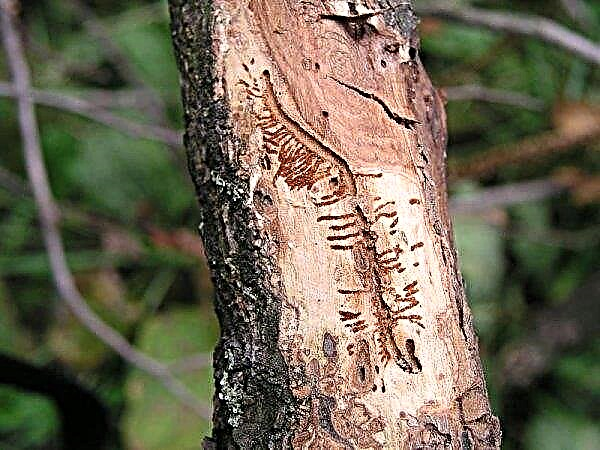The Batyany tomato variety is a high-yielding large-fruited species, with a quick ripening period, adapted to difficult climatic conditions. It tolerates temperature extremes and is unpretentious in care. Suitable for indoor and outdoor cultivation.
Origin of tomato
Tomato Batyan was bred by breeding in the XXI century. The authors of the variety were Siberian scientists V. N. Dederko, O. V. Postnikova, G. Botyaeva. The variety was added to the Russian State Register in 2008. In 2010, tomato Batyan received a patent for the outstanding achievement of Russian selection.
Did you know? An extract from the leaf plates of a tomato is used in perfumery. The essential oil contained in the leaves of the tomato gives a fresh, unobtrusive aroma with a brackish hint of sea breeze.
Description and characteristics of the variety
General characteristics of Batyany tomato varieties:
- a variety of early ripening - the crop appears after 90-100 days from the moment of diving seedlings into the ground;
- bushes of indeterminate type reach a height of 1.9–2.1 m;
- the plant forms many long lateral stems, therefore it requires mandatory pinching and garter;
- oversized leaf plates, dark green, cirrus;
- 8–10 inflorescences consisting of 4–6 simple type flowers are formed on a bush;
- pear-shaped fruits are colored in pink and raspberry;
- the average weight of one fruit is 500–600 g;
- from 10 to 24 fruits ripen on each bush;
- fruiting is long, the fruits ripen in turn;
- the skin is glossy, thin, prone to cracking;
- the pulp is juicy, fleshy, sugary with a barely noticeable acidity;
- the variety, like its subspecies, is intended for table needs, suitable for the manufacture of sauces and tomato juice;
- high productivity - 5–7 kg per bush;
- the variety is resistant to many characteristic for solanaceous diseases;
- the dimensions of the bushes allow you to place on 1 square. m no more than 2 copies.

Advantages and disadvantages
- Grade Advantages:
- high productivity;
- prolonged fruiting;
- resistance to fungal diseases;
- undemanding to the composition of the soil;
- good adaptive abilities;
- the ability to independently collect seeds from the obtained crop for the purpose of further reproduction.
- The disadvantages of the variety:
- a tendency to crack with a long stay on the bush of ripened fruits and an excess of moisture;
- high growth of bushes;
- the formation of a large number of stepsons;
- average seed germination;
- breaking branches under the weight of the fruit.
Planting and growing tomatoes at home
To get a good yield, for tomatoes it is necessary to organize a full-fledged care. The conditions for growing in open and closed ground will be slightly different.
The optimal microclimate for growing
In too dry conditions, with sudden changes in night and day temperatures, the fruits may not start. The variety prefers cooler conditions. The bushes fully develop in well-lit areas, protected from draft, at a temperature of +15 ... + 25 ° C and humidity of 70%.
When growing in a polycarbonate greenhouse, the plant grower has the opportunity to independently control the microclimate and not depend on the weather, but at the same time it is necessary to organize an elementary ventilation system so that the plants do not suffer from a lack of air.
For the good development of tomatoes in a greenhouse, it is necessary to establish:
- automatic ventilation system;
- additional lighting - lamps with sodium or LED lamps;
- infrared heater, if the goal is to harvest all year round;
- thermometers for the ability to control the temperature regime and its correction;
- drip irrigation system;
- gutters for the effective use of rainfall as moisture.
Illumination in the greenhouse is 15 hours. Air temperature - +12 ... + 25 ° C. Humidity of the soil - 80%, air - 60–70%, with full ventilation.
Land cultivation
The soil for tomatoes begins to be prepared immediately after harvesting. Plant residues must be collected and disposed of outside the site. Organic fertilizers are applied to open ground. Digging is carried out to a depth of 20–25 cm. Organics can be replaced with mineral fertilizers. Based on 1 square. m will need:
Based on 1 square. m will need:
- 40 g of superphosphate;
- 25 g of potassium salt.
Spring treatment begins 1-2 months before diving seedlings.
In the soil for each square. m contribute:
- 1 kg of bird droppings;
- 2 kg of ash;
- 25 g of ammonium sulfate.
Such a composition serves not only as a full-fledged fertilizer, but also effectively destroys pests and fungal spores wintering in the upper layers of the soil.
Important! For the entire period before transplanting seedlings to a permanent place, you need to dig the ground with a pitchfork 2-3 times. This helps to destroy the larvae of the bear and the Colorado potato beetle, which are buried in the ground and winter in it.
When grown in a polycarbonate greenhouse, the soil begins to be prepared in February - for heated rooms, in March - for unheated.
Soil preparation in the greenhouse consists of two stages:
- Recovery.
- Nutrient Enrichment.
10 cm of the topsoil is completely removed. Next, the treatment is carried out with a solution of copper sulfate - 15 ml of substance per 10 liters of water. Having carefully spilled the soil, it is left in this state for 2-3 days. Then, the soil is enriched with minerals or organic, depending on the composition:
Then, the soil is enriched with minerals or organic, depending on the composition:
- light chernozems - 5-7 kg of compost per square meter. m mixed in equal proportions with sand;
- heavy loamy - 7 kg of peat and compost per square meter. m;
- peatlands - 5–7 kg of turf land mixed with compost per square meter. m;
- sand - peat and humus of 5-7 kg per square. m
If the acidity in the soil is increased, it is regulated by making dolomite flour at 600 g per square. m. After processing, the soil is dug up and proceed to the formation of beds.
Soil for seedlings is mixed in equal proportions from:
- sand;
- peat;
- turf land;
- compost.
Before use, the earth mixture is preliminarily heat treated in an oven. Disinfection can be carried out using a hot solution with wood ash. 500 g of ash are added to 10 liters of water and boiled for 3-5 minutes. The solution immediately after boiling is poured into the soil. Once the soil has cooled, you can sow.
Seed treatment
Seed is placed in a glass with 1% manganese solution for 2 hours. Surfaced specimens are rejected, settled to the bottom, washed with running water and wrapped in moistened gauze for 18 hours.
Did you know? The pulp of ripe tomatoes helps to heal wounds and quickly get rid of burn pain. It is applied to the damaged area for 10-15 minutes, and then washed off with cool water.
Then they begin to prepare the soil for seedlings and sowing.
Sowing technology
For planting seeds, use common boxes or separate containers. Swollen seeds are sown to a depth of 0.5 cm in increments of 5-7 cm and a similar width between rows. Seeds are laid in furrows or holes (with a single planting) and sprinkled with soil.
Then the containers are covered with film or glass and kept at a temperature of +25 ° C and relative humidity of 70–80% in a semi-darkened room. With the advent of shoots, the film is removed and the temperature is lowered to +20 ° C during the day and +16 ° C at night.
Preparing for transplanting seedlings
In the process of growth, seedlings are dived with the appearance of 3 full leaf plates, then after 20-25 days they are planted. In the process of transplantation, pinch the main process of the root and dig a stem 5 cm deep into the ground.
This approach allows you to strengthen the root system and prevents the extension of seedlings, which is very important when growing tall tomatoes.
After 55–70 days, Batyany tomatoes are dived to a permanent place. About a month before this, plants begin to be prepared by performing the hardening procedure. The air temperature in the room is reduced to +18 ° C.
If there is a glassed-in balcony or loggia, seedlings begin to be set there for 30-40 minutes a day. The duration of the procedure is increased daily by 30-60 minutes, from the 5th day windows are additionally opened for 1-2 hours. Before planting at a permanent place, seedlings should spend on the balcony for 20-24 hours.
Planting seedlings in a permanent place
Planting seedlings is carried out in soil, heated to +10 ° C - for greenhouses. When planting in open ground, it is better to wait until stable warm weather is established when the danger of return frosts passes.
Did you know? Octopus tomato trees are grown in Beijing's Walt Disney World Resort. On average, one plant produces 14,000 tomatoes.
The landing pattern is the same for open and closed ground. Plants are planted in holes with a depth of 25 cm, keeping between them a distance of 60 cm and 70–80 cm between rows.
Landing process:
- Form beds and dig holes.
- Add 20 g of superphosphate to the planting pits and pour 1.8–2 liters of water.
- As soon as the liquid is absorbed, fill the pits a third with soil.
- Install support for the garter near the pits.
- Carefully remove the plants from the containers, being careful not to damage the roots.
- Place the root system in the hole and sprinkle with soil.
- Tamp the soil and pour 500-800 ml of water into each well.
- Tie the seedlings to the support.
- Mulch the beds.
How to care for tomatoes
Productivity of tomatoes depends on the features of the organization of care for them. In greenhouse conditions, tomatoes are kept at a temperature of +19 ... + 22 ° C before fruiting. When entering the flowering phase, it is necessary to reduce air humidity to 50%. The drier it is, the easier it will be to separate pollen from pistils. For pollination to be successful, ventilation alone is not enough. It is necessary to shake the upper flower beds during the day so that the pollen settles on the lower ones, or transfer it with cotton buds.
The drier it is, the easier it will be to separate pollen from pistils. For pollination to be successful, ventilation alone is not enough. It is necessary to shake the upper flower beds during the day so that the pollen settles on the lower ones, or transfer it with cotton buds.
The rest of the care for tomatoes in a greenhouse and open ground is practically the same.
Top dressing
For the season 3 feeding is carried out:
- 10 days after diving seedlings into the ground - liquid mullein + dusting the holes with ash;
- 10-14 days after the first feeding - 500 g of bird droppings + 40 g of superphosphate per 10 l of water;
- during the formation of the ovary - 10 g of yeast per 10 l of water.
Watering
Water is applied directly under the root. Liquid on the greens leads to the development of a fungal infection. Water temperature for irrigation - +18 ... + 20 ° C. Use only defended soft water.
In open and closed ground, it is best to use a drip or ditch irrigation system. This will allow you to economically distribute water and maintain optimal soil moisture, eliminating waterlogging.
Stepson
Small lateral processes do not bear fruit, but take nutrients and water, which impedes the normal development of the fruit.
Important! The processes 3-5 cm long are subject to removal. If they are larger, they should not be cut off - there is a high risk of infection.
In addition to shoots, extra brushes are removed. In greenhouse conditions, pinch leaves and brushes every 7-10 days. In the open ground they are guided not only by these terms, but also by weather conditions. The procedure is not carried out immediately after watering or rain, you need to wait until the soil dries.
In the open ground they are guided not only by these terms, but also by weather conditions. The procedure is not carried out immediately after watering or rain, you need to wait until the soil dries.
The scheme of pinching in 1 shoot:
- pinching of the main stem after the formation of 5-6 brushes;
- on the second shoot, pinch the top during the formation of 1 brush;
- after tying the main number of fruits - 6-10 brushes, the remaining inflorescences are removed;
- removal of old leaves under the ovary and one above it is carried out as it ripens;
- each shoot is securely fixed to the support.
Pinching small shoots is carried out with clean hands - this injures plants less than pruning with a knife.
Tying and shaping a bush
Tying is carried out immediately after transplanting to a permanent place. As they grow, all shoots are fixed to the support.
For tying, several options are used:
- Stakes - plants are fixed to a wooden support, which exceeds their estimated growth by 20-30 cm. Suitable for bushes formed in 1 stalk.
- Horizontal and vertical trellis - at the beginning, at the end and in the middle of the beds, supports are mounted on which the wire is attached horizontally or vertically. As the plants grow, they are fixed at different heights.
- Grid - between the beds set the grid. The design is similar to the previous one, but it allows you to fix 1 plant on each side, which will save time on the organization of individual supports.
 The formation of the bush is possible in 1, 2 or 3 stems. In the first case, remove all side shoots and brushes with a knife, leaving 6-8 ovaries on the main shoot. In the second case, leave one strong lateral shoot formed under the first brush. In the third case, an shoot formed under the 2nd brush is left on the bush.
The formation of the bush is possible in 1, 2 or 3 stems. In the first case, remove all side shoots and brushes with a knife, leaving 6-8 ovaries on the main shoot. In the second case, leave one strong lateral shoot formed under the first brush. In the third case, an shoot formed under the 2nd brush is left on the bush.Important! All work is carried out with a clean, alcohol-disinfected tool. The main thing is to prevent the juice from getting on your hands, and after each plant to process the tool. The presence of fungal spores in the soil or on plants is not immediately noticeable, but they are transmitted with juice from the patient to a healthy tomato.
Soil loosening
After each watering, applying liquid fertilizers and rain, the soil is loosened, followed by mulching. The optimal aeration depth is 5 cm near the plants, 10 cm in the aisles. Simultaneously with loosening, weed removal is carried out.
Growing difficulties
Possible diseases:
- Late blight. The causative agent is fungal spores that multiply rapidly in moist soil. When dark spots appear on the leaves, they must be immediately removed and burned outside the site. Next, processing is carried out with a 3% solution of Bordeaux liquid. After 20 days, a second procedure follows. If necessary, a third treatment is carried out, but until 4 brushes are tied. After spraying, the ripe fruit is not edible for another 3 weeks.
- Cladosporiosis. The disease also causes fungus. The problem is solved in the same way as described above.
Of the pests are dangerous:
- Medvedka - is eliminated with the help of the drug "Thunder". 1 tsp. the drug must be decomposed into the mink of the pest and moisten the soil.
- Colorado beetle - eliminated with a solution of "Actara" 8 g per 10 liters of water. The flow rate of the working solution is 1 liter per 10 square meters. m
 To avoid problems with the spread of fungus and pests, you must follow agricultural practices.
To avoid problems with the spread of fungus and pests, you must follow agricultural practices.The most important points in this matter are:
- plowing the site in autumn and spring by 20–25 cm;
- preventive treatment of plants with a 1% solution of Bordeaux fluid from the 10th day of plant life in a constant place;
- pinching of lower shoots and foliage;
- thorough cleaning of plant residues from the site.
Harvesting and storage
Gather tomatoes as they ripen, to prevent breakage of branches. Fruits are carefully separated from the brush with the peduncle. Store in cardboard or wooden boxes, laying out in one layer, in darkened cool rooms. Whole, not damaged fruits with peduncles retain their original qualities for 7–10 days.
Did you know? Swiss gardener M. Cobert brought a hybrid of tomato and apple. This fruit has a sweet and sour taste, reminiscent of apple. Outwardly, it looks like an apple, but inside it is a real tomato. The bright color of the fruit remains even after heat treatment, and its juice becomes similar in taste to cranberry.
The Batyany tomato variety is distinguished by good productivity and high adaptive abilities. Suitable for indoor and outdoor cultivation.


